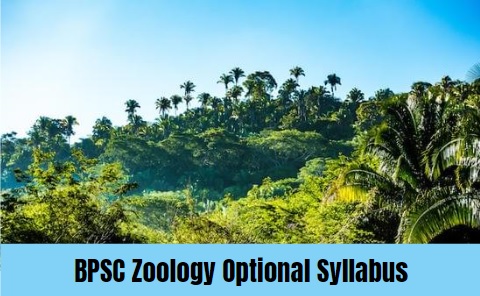As a BPSC aspirant you have to opt for one optional paper in BPSC Mains Examination. There are around 34 optional subject in BPSC Mains from which you have to chose only one. Zoology is one among them. The optional deals in the study of science of animals .It is a scoring optional. Optional subject has been made qualifying and BPSC has changed the format of optional into MCQs from BPSC 68th. In this post you will know about the syllabus of Zoology Optional for BPSC Mains.

BPSC Zoology Optional Section- 1
Non Chordata and Chordata, Ecology, Ethology, Biostatistics and Economic Zoology
Part- A
1. A general survey, classification and relationship of the various phyla.
2. Protozoa: Study of the structure, bionomica and life history of Paramaecium, Monocyotis, Malarial Parasite, Trypanosoma and Leishmania. Locomotion, Nutrition and reproduction in Protozoa.
3. Porifera: Canal system sheleton and reproduction.
4. Coelenterata: Structure and life history of Obelia Aurelia, Polymorphism in Hydrozoa, Coral formation, Metagenesis, Phylogenetic relationship of Cinideria and Acnidaria.
5. Helminths: Structure and life history of Planaria, Fasciola, Taenia and Ascaris. Parastic Adaptation,
Helminths in relation to man.
6. Annelida: Nereis, Earthworm and Leech, Coelom and Metamerism, Modes of life in Polychaectes.
7. Arthropoda: Paleomon, Scropion, Cockroach. Larval forms and Parasitism in Crustacea, Mouth part vision and respiration in arthropods, Social life and Metamorphosis in insects. Importance of Paripatus.
8. Mollusca: Unio Pila, Oyster Culture and Pearl formation, Cephalopods.
9. Echinodermata: General organçation, Larval, forms and affinities of Echinodermata.
10. General organçation and characters, Outline classification and interrelationship of Protochordata, Pisces, Amphibia, Reptilia, Aves and Mammalia.
11. Neoteny and retrogressive Metamorphosis.
12. A general Study of comparative account of the various systems of Verterbrates.
13. Locomotion, Migration and respiration in fishes, Structure and affinities of Dipnoi.
14. Origin of Amphibia, distribution, Anatomical Peculiarities and affinities of Urodela and Apoda.
15. Origin of Reptiles, Adaptive Radiation in Reptiles, fossil Reptiles, Poisonous and non-Poisonous Snakes of India, Poison Apparatus of Snake.
16. Origin of Birds, Flightless Birds, Aerial adaptation and migration of Birds.
17. Origin of Mammals, Nomologies of ear ossicles in Mammals, Dentition and Skin derivatives and Manmmals, Distribution, Structural Peculiarities and Phylogenetic relation of Prototheria and Methatheria.
Part- B
Ecology, Ethology, Biostatics and economic Zoology
Ecology:
1. Environment: Abiotic factors and their role, Biotic factors – and Inter – specific relations.
2. Animal: Organisation at population and community levels, ecological successions.
3. Ecosystem: Concept, Components, Fundamental operation, Energy flow, Biogeo-chemical cycle, food chain and Trophic levels.
4. Adaptation in fresh water, Marine and Terrestial habitats.
5. Pollution in air, Water and Land.
6. Wild life in India and its conservation.
Ethology:
7. General survey of various types of animal behaviour.
8. Role of hormones and pheromones in behavioures
9. Chronobiology: Biological check, Seasonal Rhythms, Tidal Rhythms.
10.Neuro-endocrine control of behaviour.
11. Methods of studying animals behaviour.
Biostatistics
12. Methods of sampling, Frequency distribution and measures of central tendency, Standard deviation,
Standard error and Standard deviance, Correlation and Repression and Chi-square and f-test.
Economic Zoology
13. Parasitism, Commensalism and host Parasite relationship.
14. Parasitic Protozoans, Helminthes and insects of man and domestic animals.
15. Insect pests of crops and stored products.
16. Beneficial insects
17. Pisciculture and induced breeding.
BPSC Zoology Optional Section-2
Cell Biology, Genetics, Evolution and Systematics, Bio-chemistry, Physiology and Embryology.
Part-1
Cell Biology, Genetics, Evolution and Systematics.
1. Cell Biology- Structure and function of Cell and Cytoplasmic Constituents, Strtucture of Nucleus, Plasma Membrane Mitochondria, Golgi bodies, Endoplasmic Reticulum and Ribosomes, Cell Division, Mitosis Spindle and Chromosome movements and Meiosis. Gene structure and function, Watson-Crick model of DNA, replication of DNA Genetic code, Protein Synthesis, Cell differentiation, Sex-chromosomes and Sex determination.
2. Genetics – Mendelian laws of inheritance, recombinations, Linkage and Linkage Maps, Multiple, Allels, Mutation (Natural and Induced), Mutation and Evolution Meiosis, Chromosome number and form, Structural rearrangements, Polyploidy, Cytoplasmic inheritance, Regulation of Gene expression in Prokaryotes and Eukaryotes. Bio-chemical Genetics, Elements of human Genetics, Normal and Abnormal Karyotypes, Genes and Diseases. Eugenics.
3. Evolution and Systematics, – Origin of life, history of evolutionary thought, Lamarck and his works. Darwin and his works, sources and nature of organic variation, Natural selection, Hardy-weinberg law, Cryptic and warning colouration mimicry, Isolating mechanisms and their role. Insular fauna concept of species and subspecies, Principles of classification, Zoological nomenclature and International Code. fossils, outline of geological cras phylogeny of Horse, Elephant, Camel, Origin and evolution of man, Principles and theories of continental distribution of animals, Zoo geographical realms of the world.
Part-2
Bio-chemistry, Physiology and Embryology:
Bio-chemistry: Structure of Carbohydrates, Lipids, Amino-acids, Proteins, and Nucleic Acid, Glycolysis and Krebs Cycle, Oxidation and reduction, Oxidative Phosphorylation, Energy conservation and release ATP, Cyclic AMP, Saturated and unsaturated fatty acids, Cholesterol, Steroid hormones, Type of enzymes, Mechanism of enzyme action, Immunoglobulins and Immunity, Vitamins and coenzyme, Hormones their classification,Biosynthesis and functions.
Physiology with special reference to Mammals, Composition of blood, Blood groups in man, coagulation, Oxygen and carbon-dioxide Transport, Haemoglobin. Breathing and its regulation, Nephron and Urine formation, Acid-Base balance and homeostasis, temperature regulation in man, mechanism of conduction along axon across Synapses, Neurotransmitters, Vision, Hearing and other receptors, Types of Muscles, Ultra structure, and mechanism of contraction of Skeletal Muscle, Role of Salivary Gland, Liver Pancreas and intestinal glands in digestion Absorption of digested food, Nutrition and balanced diet of man, Mechanism of action of Steroid and Peptide Hormones, Role of hypo-thalamus, Pituitary Thyroid, Parathyroid, Pancreas, Adrenal, Testis, Ovary and Pineal organs and their inter-relationships, Physiology of reproduction in humans, Hormonal control of development in man and insects, Pheromones in insects and Mammals.
Embryology: Gametogenesis, Fertilisation, Types of Eggs, Cleavage, development upto gastrulation in Branchiostoma, Frog and Chick, Fate maps of Frog and Chick. Metamorphosis in Frog, Formation and Fate of Extra Embryonic menbranes in Chick Formation of Amnion. Allantois and types of placenta in Mammals, Function of Placenta in Mammals, Organisers, Regeneration, Genetic control of development. Organogenesis of central nervous system, sense organs heart and Kidney of vertebrate embryos. Aging and its implication in relation to man.
BPSC Zoology Optional Syllabus FAQ
Is Zoology a good optional for BPSC?
Zoology is a good optional for BPSC Mains for those candidates who have interest in the field of zoology or who have studied this subject in their graduation and in general the syllabus is given in detail. There are candidates who have qualified after opting zoology as optional in both UPSC as well as BPSC. This is a hot optional for (IFos) Indian Forest Service Examination candidates.
What is BPSC Zoology Optional Syllabus?
The syllabus for the BPSC Zoology Optional is given above.
In Zoology what we need to study?
Zoology is the science of animals and has application in various fields that are encountered in the earth ecosystem.

